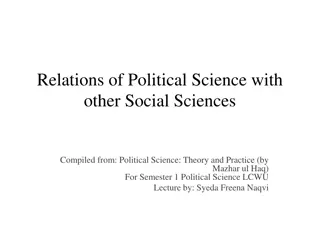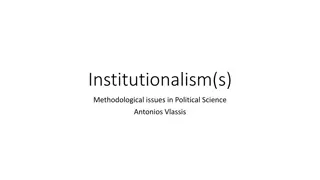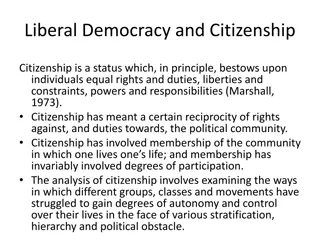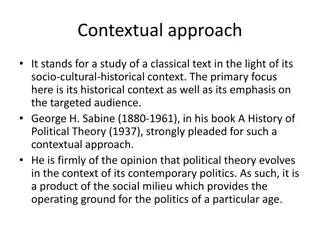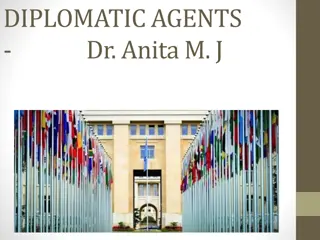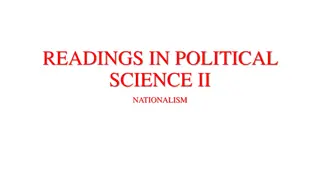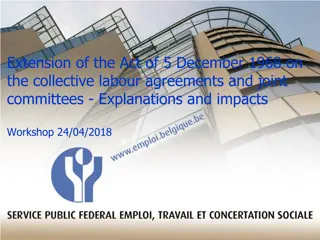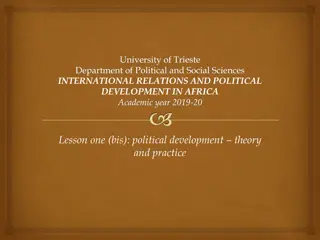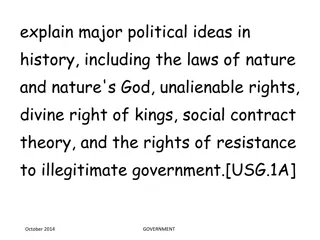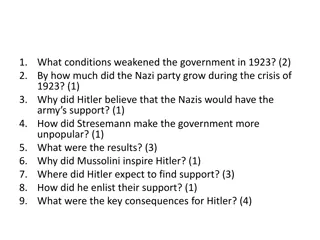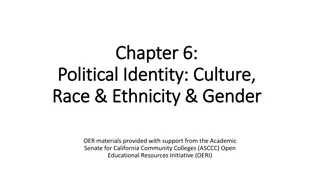Political and Diplomatic Developments of the 1620s
The 1620s were marked by key political and diplomatic developments including the issuance of the Edict of Restitution by Ferdinand II in 1629. Warfare financing, military conflicts, and the revival of Catholicism in the Empire stirred mixed reactions from France and Spain. The era also saw significant events in Spain under Philip IV and in France under Louis XIII, particularly in relation to Spain's war with the Dutch and Habsburg encirclement.
Uploaded on Sep 16, 2024 | 1 Views
Download Presentation

Please find below an Image/Link to download the presentation.
The content on the website is provided AS IS for your information and personal use only. It may not be sold, licensed, or shared on other websites without obtaining consent from the author.If you encounter any issues during the download, it is possible that the publisher has removed the file from their server.
You are allowed to download the files provided on this website for personal or commercial use, subject to the condition that they are used lawfully. All files are the property of their respective owners.
The content on the website is provided AS IS for your information and personal use only. It may not be sold, licensed, or shared on other websites without obtaining consent from the author.
E N D
Presentation Transcript
Wilson, Peter H., ed. The Thirty Years War: A Sourcebook, docs. 8, 32. New York: Palgrave Macmillan, 2010. OR A Calvinist prince s view: Christian II of Anhalt s diary. In Wilson, Peter H., ed. The Thirty Years War: A Sourcebook, 149-50. New York: Palgrave Macmillan, 2010. The Upper Austrian Peasants Rising, 1626. In Wilson, Peter H., ed. The Thirty Years War: A Sourcebook, 72-73. New York: Palgrave Macmillan, 2010.
Articles of the Bohemian Confederation Ferdinand II s plan for Habsburg lands Treaty of Munich (1619) Treaty of Ulm (1620) Perspective from the ground
What were the key political and diplomatic developments of the 1620s? 1. How was warfare financed? 2. What were the main military conflicts in the 1620s? 3. Ferdinand II issued the Edict of Restitution in 1629. Why was this act a grave error (p. 446)? 4. These questions represent an analysis of the assigned reading that is based entirely on Europe s Tragedy but that does not always strictly follow the progress of Wilson s presentation, especially with reference to questions 1 and 3.
Mantua and environs http://1.bp.blogspot.com/_KezhQ6waZT0/SDDkG U-R85I/AAAAAAAAEMw/N0DeJSIr8FA/s1600- h/mantua.jpg Baltic region http://www.emersonkent.com/map_archive/baltic _regions_1386.htm Central Europe, 1618 http://www.hup.harvard.edu/features/wilson/wil soncemap.jpg
The revival of Catholicism in the Empire was received with mixed feelings by France and Spain (p. 362).
Spain Philip IV (1621-1665) Gaspar de Guzm n, Count- Duke of Olivares reputaci n and war with the Dutch enhancement of Spain s navy Admiralty of the North Union of Arms (p. 370) soldiers and tax problems financial crises (pp. 434-35) bankruptcy of 1627 capture of treasure fleets, 1627, 1628
France Louis XIII (1610-1643) court factions d vots vs. Bons Fran ais Cardinal Richelieu chief minister (1624-1642) The interests of a state and the interests of religion are two entirely different things (1616, p. 377). a dangerous opponent (p. 379) for Spain (Olivares) Habsburg encirclement
France Edict of Nantes (1598) Huguenot rebellions, 1620s distraction from international involvement siege of La Rochelle (1627- 1628, pp. 440-42) Peace of Alais (1629)
Cardinal Richelieus four strategies 1. general alliance against Spanish dominance and for European peace 2. bilateral alliances: money and troops 3. protection for weaker territories in exchange for transit of French troops 4. limited warfare for the sake of protection strategy fundamentally flawed (p. 381).
Danish involvement Christian IV (1588-1648) interest in German bishoprics (p. 386) rivalry with Sweden Treaty of the Hague, 1625
rise of Albrecht von Wallenstein (1583-1634) defection to Emperor, 1619 a major beneficiary of the land transfers (p. 392) Duke of Friedland, 1624 commander of Imperialist forces, 1625 Duke of Mecklenburg, 1629 upstart, critical of subordinates
other commanders Wallenstein General Tilly Maximilian I, Catholic League recognition of his electoral title by Saxony (1624) and Brandenburg (1627) Regensburg Electoral Congress, 1630 a significant demonstration of the Empire s collective purpose (p. 454) dismissal of Wallenstein
state taxation, e.g. war taxes (p. 456) borrowing military officers plunder credit: for raising an army muster system: towns provide food and wages for an entire troop contributions ( tax of violence / extortion): to be paid also after a troop has left a region challenges pay arrears camp followers
surrender of Breda (siege: August 1624-June 1625) = pyrrhic victory (p. 434) Dunkirk privateers: attack on Dutch ships Treaty of Compi gne (1624): France and Dutch Republic subsidies from France for Dutch naval support Frederick Henry of Nassau
Piet Hein: capture of Spanish treasure fleet (1628) Spain s inability to send reinforcements to the Netherlands placed a premium on imperial assistance (p. 436) siege of s Hertzogenbosch (Bois-le-duc), 1629
Holy Slaughter in the Valtellina, July 1620 diplomatic solution: papal troops replaced Spanish troops Savoy s attack on Genoa, 1625 French conquest of the Valtellina Treaty of Monz n, 1625: a Catholic Valtellina; replacement of French with papal troops Savoy s alliance with Spain
War of the Mantuan Succession (1628-1631) claim of Charles of Nevers upon Mantua: 1627 under Imperial jurisdiction (Ferdinand II) control of Montferrato: Spain and Savoy fortress of Casale: taken by Charles, 1628 Imperial intervention: Madrid failed to see that its assertiveness in Italy forced the emperor to intervene to preserve his own authority, rather than because he wished to counter France (p. 443). fall of Mantua (1629) solutions: Peace of Regensburg (1630), Peace of Cherasco (1631): Charles in Mantua; preservation of Imperial jurisdiction; tensions with Spain
motives ecclesiastical property, not religious solidarity (p. 387) misgivings of Danish nobility Treaty of the Hague (1625) England, Dutch Republic: aid for Denmark strategy Danish attack in northern Germany attack of Bethlen (d. 1629) from Transylvania
Imperialist reaction neutrality? Tilly to Hessen: It s called obedience, not neutrality. Your lord is an imperial prince whose overlord is the emperor (p. 389). imperial order (7 May 1624) Battle of Dessau Bridge (1626) Wallenstein vs. Mansfeld (d. 1626) Battle of Lutter (1626) Tilly vs. Christian IV Interlude: Upper Austrian Rebellion (1626) the problem of re-Catholicization
Imperialist reaction 1627 campaign against Holstein Peace of L beck (1629) Denmark lost none of its own territory. Denmark agreed to abandon claims to bishoprics 2. keep out of Imperial affairs a gift from heaven (p. 423) 1.
Background: Swedish southern advance (1621- 1627) Austro-Spanish naval cooperation (p. 426) blockade of Magdeburg, siege of Stralsund Stralsund (1628): Gustavus German base (p. 431)
Imperial intervention in Poland goal: dislodge Swedes from Vistula delta limited success Truce of Altmark (1629) facilitated by France Sweden abandoned Courland, most of Livonia, and all but three Prussian ports Richelieu s plan redirect Sweden s attention away from Poland and towards the Holy Roman Empire
Ferdinand committed a grave error by issuing the Edict of Restitution in March 1629 (p. 446) a blunder of the first order (p. 453) a failed attempt to establish peace connected to the controversial land transfers, contributions and military demands that stirred well-founded suspicions in many Catholics as well as Protestants (p. 446)
a glorious enterprise God on the Catholic side militant Catholic interpretation of the Peace of Augsburg Paul Laymann SJ, Pacis compositio (1629) William Lamormaini SJ (1570-1648): surpassed Ferdinand in religious fundamentalism (p. 447)
a judicial, not a religious act a return to the clear letter of the Peace of Augsburg? Calvinism excluded return of ecclesiastical property secularized after 1552 recovery of 6 bishoprics, 2 imperial abbeys, ca. 150 monasteries, convents, churches not a uniform attack on German Protestants (p. 449) main victims: Denmark, Guelphs, W rttemberg
Catholic dismay: Spain, Bishop of Vienna, Wallenstein; religious orders vs. bishops Protestant response alienation of moderate Lutherans Johann Georg s arguments about Peace of Augsburg in favour of suspending implementation
Consequences Catholic disunity adamant Protestant opposition to wholesale restitution vs. case-by-case investigation the vitality of an Empire- wide political culture (p. 453) that valued reasonable compromise Regensburg Electoral Congress, 1630 opposition to Wallenstein opposition to Mantuan War


